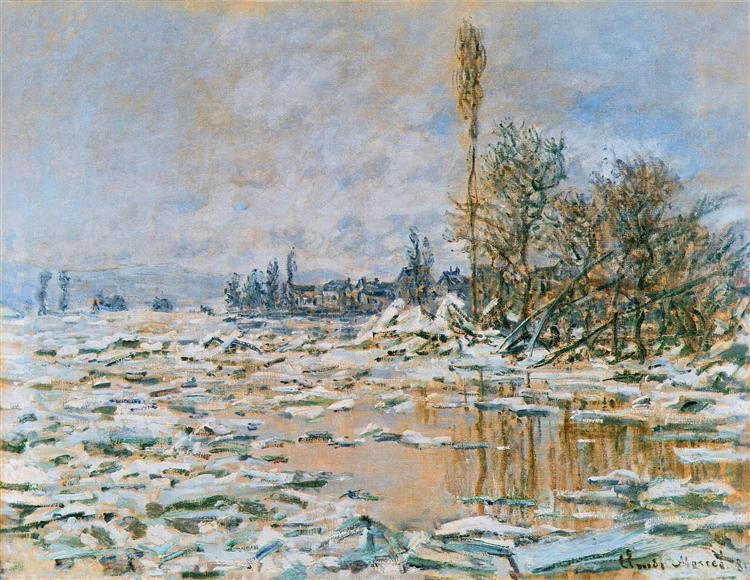Beschreibung
The work "Breaking Ice - Lavacourt - Grey Time", painted by Claude Monet in 1880, captures one of the most fascinating characteristics of Impressionist painting: the fleeting depiction of light and color at a specific instant in time. This painting stands out not only for its subject matter, which reflects a moment of transition in nature, but also for its innovative technique and its ability to invoke emotion through the depiction of the landscape.
The composition of the work is notable for its horizontality, where the horizon divides the canvas into two halves, letting the water and sky intertwine in a symphony of grey tones. Monet presents us with a winter landscape in which the ice is breaking up, suggesting both a struggle and a release. Despite its apparent stillness, the painting breathes movement; the fractures in the ice surface seem to open and close with the rhythm of the landscape. This sense of impermanence is a recurring theme in Monet's work, a reflection of his fascination with the constant change of light and weather.
The palette used in this work is characteristic of the Monet of his time, with moody shades of grey and blue predominating, interspersed with subtle nuances of white that lend a sense of freshness and, at the same time, a wintry coldness. This use of colour not only sets the mood of the scene, but also evokes an emotional response in the viewer. The greyish atmosphere and diffused light suggest an overcast day, where the sun struggles to break through the clouds, a representation that suggests the struggle between life and death, permanence and transience.
In the foreground, Monet places fragments of floating ice that act as elements of visual interest, creating a contrast with the subtle hues of the underlying water. Although there are no human figures in this work, the very absence of characters allows the viewer to become fully immersed in the sublime beauty of the nature depicted. Without the distractions of the human figure, attention is focused on the interplay of natural elements, an echo of the Impressionist philosophy that seeks to capture the essence of a scene rather than its literal representation.
Interestingly, Breaking the Ice is part of a period when Monet was intensely experimenting with the depiction of water and its reflection, as is evident in his other works such as Impression, Sunrise or The Nymphs. In all of these pieces, Monet harnesses color and light to transform the everyday into the sublime, revealing his deep connection with nature and his endless admiration for its nuances.
The significance of this work lies not only in its aesthetic beauty, but also in its ability to capture an ephemeral fragment of time, inviting the viewer to reflect on the passage of time and natural cycles. “Breaking Ice – Lavacourt – Grey Time” is a masterful display of how Claude Monet, through his innovative approach and haunting sensitivity, managed to open up new avenues in art, leaving a legacy that still resonates in the contemporary art world today. His ability to portray the essence of a specific moment resonates with enduring relevance, allowing viewers to navigate their own memories and emotions when contemplating this stunning work.
KUADROS ©, a famous painting on your wall.
Hand-made oil painting reproductions, with the quality of professional artists and the distinctive seal of KUADROS ©.
Painting reproduction service with satisfaction guarantee. If you are not completely satisfied with the replica of your painting, we will refund 100% of your money.

